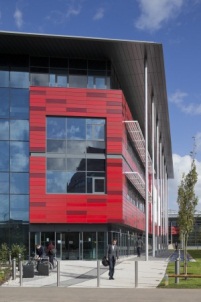Institute of Mental Health Building is 'excellent'

The new Institute of Mental Health Building, on Jubilee Campus, has received an ‘Excellent’ BREEAM rating in line with the Building Research Establishment’s environmental assessment methodology (BREEAM).
The building, which houses state-of-the art office accommodation combined with teaching and lecture space, incorporates various sustainable technologies and passive design features such as:
- rainwater harvesting
- air source heat pumps
- high levels of thermal insulation
- solar shading on south elevation to reduce summer heat gains
- high specification glazing to reduce solar heat gains
- energy efficient lighting
Built on former industrial land, environmental impacts were considered from the outset of the building development, with the removal of ground pollution and contractors using recycled aggregate, returning packaging to suppliers and using only FSC-certified timber.
Heating is provided by a biodiesel combined heat and power plant in the adjacent Energy Technologies Building (via a small district heating mains pipe) and high efficiency air source heat pumps within the IMH Building, which take heat from the air and boost it to a higher temperature using the pumps. This equipment is in turn backed up by high efficiency gas fired boilers.
The building has been designed to expose the concrete soffits of the ceilings within the main accommodation areas. The exposed thermal mass of the concrete creates a heat sink for the building and hollow cores are used to distribute fresh air. This ‘termodeck’ system provides free cooling by absorbing the heat generated within the working environment throughout the day.
Further energy savings are achieved during the heating season by the ventilation system transferring heat from the warm stale exhaust air to fresh incoming air.
The result of these systems is that dynamic thermal modelling predicts the carbon emissions generated by heating, ventilating and cooling the building will be 16% less than a notional building with high efficiency gas fired heating plant.
Water consumption is minimised by the installation of waterless urinals and a rainwater harvesting tank. All rainwater from the building’s roof is collected in an underground tank, filtered and transferred into the building ready to be used for flushing the toilets.
The University has set the ambitious target of BREEAM excellent as a minimum for all new capital projects.